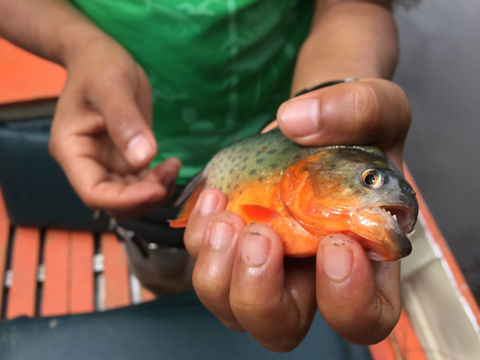New IPCC report Crop losses due to drought and extreme heat have tripled in Europe in the last 50 years
Clownfish make firm clicking noises with their teeth to defend their sexual privilege.
Sea toads in heat let out a high-pitched hiss when a female walks by.
Red piranhas intimidate each other with something like small barks.
The corvinas of the Gulf of California (
Cynoscopen othonopterus
) emit a noise so powerful that it can make other marine creatures deaf.
And dolphins, belugas and toothed cetaceans navigate using "nature's sonar": the bounced echo of their own sounds.
The sea and river depths, despite appearances, are not exactly a silent place.
Sound travels up to five times faster in water and over much greater distances.
Using their teeth, pharyngeal organs, or swim bladders as sounding boards, the sea creatures make use of a wide spectrum of "noises" ranging from snaps to growls.
Although inaudible from the surface, we are facing
a true "natural choir of the oceans" that is increasingly suffering from greater human interference.
Scientists from a dozen countries have now joined forces to make a global inventory of aquatic sounds, baptized as Glubs for its acronym in English (Global Library of Underwater Biological Sounds).
The initiative has had a wide echo after its publication in
Frontiers in Ecology and Evolution
.
Of the 250,000 known marine species, it has been confirmed that 126 mammals, 100 invertebrates and at least 1,000 species of fish emit sound (
although it is estimated that the number could reach 22,000).
To communicate, mate and find their way around, to search for food or scare away predators, marine water species use sounds as true lifesavers.
"The importance of sound in the oceans is comparable to that of light in the atmosphere,"
says the American scientist and environmentalist Jesse Ausubel, founder of the International Quiet Ocean Experiment (IQOE) and one of the promoters of the Glubs project.
"The physics of the oceans raises precisely the sound to the highest level of the senses", clarifies Ausubel.
"There is much in the seas that we cannot see, but we can hear. Soundscapes allow us to gauge the variety of species, their distribution and their abundance. The sound of the sea is the great indicator of biodiversity."
A Red PiranhaDurrell D. Kapan
"
We need to better understand what the sounds of healthy habitats
are and how changes in the environment are impacting them," warns Miles Parsons, of the Australian Institute of Marine Science and head of the GLUBS project.
"Biodiversity decline, human interference and climate change are altering the distribution and behavior of species.
With passive listening systems, we have the ability to document, quantify and understand soundscapes before they potentially disappear."
"Some animals are moving to higher latitudes to stay in the same temperatures,"
says Parsons.
"Others are responding to stressors with changes in their behavior: for example, increasing the frequency of their sounds, or making them louder so they are not masked."
Put to choose between his favorite underwater sounds, Miles Parsons leans towards the powerful vibration emitted by the
Argyrosomus japonicus
(of the sciaenid family) in the Swan River in Australia, recorded as "the loudest aquatic sound in the world"" until in 2017. Or maybe the bearded seal: "A spiral trill that sounds like something out of a space program" And of course the chorus of growling fish in Darwin Bay, "coordinated with the sunsets and with high tides."
Jesse Ausubel picks up the baton and reminds us how important "non-biological" aquatic sounds are, such as the breaking of waves, raindrops and the cracking of ice: "Marine life uses the natural knowledge of these sounds and hangs out with them."
Hydrophones and artificial intelligence
"Thanks to hydrophones and new technologies, we have gained much more knowledge in recent decades, although we hope that the GLUBS project will help us to have the complete picture", predicts Ausubel.
"We want it to be a platform and space shared by researchers, to which citizens can also join with their own contributions and using low-cost recording equipment."
Ausubel also relies on the
application of artificial intelligence when it comes to identifying the variety of sounds
and perhaps deciphering the lyrics and music of the "love songs" of marine animals, which already have thousands of admirers on portals such as FishSounds.
AIMS
The first and last purpose of GLUBS however is to raise awareness of how important it is to
preserve "soundscapes" and mitigate or prevent "anthropogenic noise".
The main source of noise pollution is undoubtedly that caused by ships, which interfere so much with the routes and with the habitats of cetaceans.
Interestingly, in the same way that happened in cities,
the economic "pause" of Covid translated into a notable decrease in noise due to the decrease in maritime traffic
.
Industrial fishing, military sonars, marine sound prospecting to detect pockets of gas or oil or the construction of wind farms are other dissonant threats to the music of the sea.
"Fortunately, it's not all bad news," concludes Miles Parsons.
"Significant changes are being made to ship propulsion systems and designs to reduce noise. Surveys are also testing less disruptive methods. And political action is finally beginning to be taken to minimize noise impact on marine sanctuaries." ".
Conforms to The Trust Project criteria
Know more
Environment
EnvironmentThe first ecological "think tank" of the Spanish right
Climate crisis Annual deaths from extreme heat in Spain will go from 1,500 to 8,000 in 2050 if emissions remain high
EnvironmentA European experiment achieves a new fusion energy record and paves the way for this new energy source
See links of interest
Last News
Topics
Work calendar 2022
Time change
best colleges
Real Betis - Rayo Vallecano
Barca - AS Monaco
Davis Cup, live: Roberto Bautista - Gabi Adrian Boitan
Davis Cup, live: Carlos Alcaraz - Marius Copil
DSC Arminia Bielefeld - FC Augsburg

